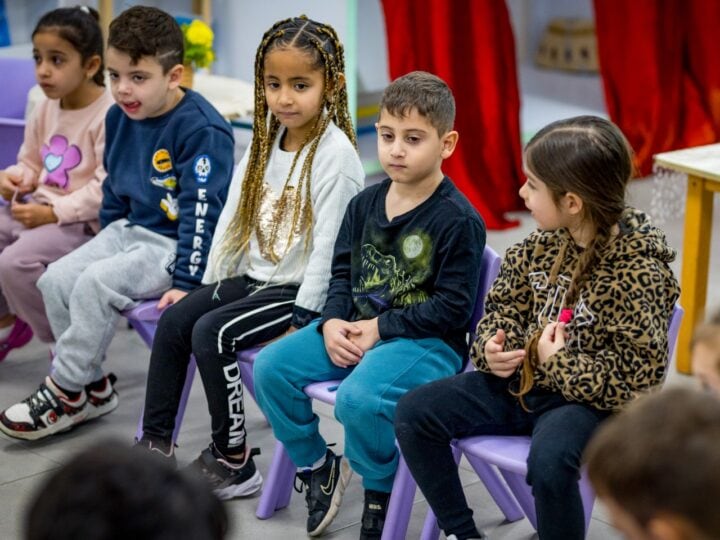They may come from worlds apart, but leading political and environmental figures from Israel, Jordan, and the Palestinian Authority have found a common theme to bring them together – the Great Rift Valley.
The Great Rift Valley is a series of geological rifts stretching 4,000 miles, from southern Turkey to Zimbabwe, running through Syria and Lebanon, along the Jordan River, the Dead Sea, the Gulf of Eilat and the Red Sea until Kenya, at which point it splits into two branches. Five hundred million birds use the valley route to migrate twice a year from Europe to Asia.
The multi-national group – under the moniker of the Dead Sea Triangle (DST) – has met twice recently, in Jerusalem and at Kibbutz Sde Eliyahu, to discuss the future of the Great Rift Valley and to step up the environmental collaboration already in progress through innovative and large-scale projects.
Sessions were organized by Dr. Yossi Leshem from Israel’s Society for the Protection of Nature and Tel Aviv University. Together with his partners in the project – Imad Atrash of the Palestine Wildlife Society and retired Jordanian general Mansour Abu Rashed – Leshem envisions a triangle of research facilities (known as the Dead Sea Triangle) in the Great Rift Valley, Ein Gedi, Jericho, and Wadi Mujeb in Jordan.
“Migratory and local birds are playing a key role in our collaboration, bringing people together: farmers, educators and scientists. The results of the birds’ activities are far more profound than those of the politicians,” Leshem told ISRAEL21c.
The global aim of the DST initiative is to provide a platform for dialog though cooperative research and education in the Dead Sea region. Three leading institutions of higher education, Al-Balqa University (ABU) in Jordan, Al-Quds University (AQU) in East Jerusalem, and Tel Aviv University (TAU) in Israel, will each set up a Dead Sea Research Hub along the shores of the Dead Sea to jointly contend with a series of scientific challenges common to all three parties.
While the group is currently fundraising for a research center and research bases in all three countries, work has already begun on one project – reducing agricultural reliance on pesticides.
Barn Owls and kestrels prey on rodents that attack crops, so farmers are learning to build nesting boxes to sweeten the birds’ attraction to the area; once the birds of prey inhabit the farm, the farmer is free to discontinue use of chemical pesticides. Apparently the owls breed more when there is enough food for their young – and in the midst of Sde Eliyahu’s wheat fields, these owls are laying far more eggs than usual and their young are of various ages.
In 2004, the Tel Aviv Municipality began using kestrels and barn owls for biological pest control, exterminating rats and mice in urban courtyards. Eight local schools joined in the education efforts to promote this project. More recently, Jordanian and Palestinian farmers decided to join SPNI’s project to reduce pesticide use.
“It is a good experience to learn from the Israelis and this project, in particular, is very important for our health and environment because we are getting rid of the rodents and pests plaguing farmers in a natural way,” said Atrash, who has worked in close alliance with Leshem and the SPNI for years.
In January 2006, the Cleveland Federation helped fulfill this vision – funding research and conservation activities with Jordanian farmers, and 20 nesting boxes for barn owls and kestrels on the eastern shores of the Jordan River, across the river from the Bet She’an Valley.
The program is coordinated by Rashed, a retired senior Jordanian Intelligence Officer and one of the leaders of the Israel-Jordan peace process; Rashed is currently the chairman of the Amman Center for Peace and Development (ACPD). He explained that in the Muslim tradition, barn owls symbolize bad luck. Thus, many of the Jordanian farmers were hesitant to cooperate at first. Yet after a few farmers used barn owls instead of chemical pesticides with tremendous success, others were quick to follow suit.
An integral part of the Dead Sea Triangle Initiative, the proposed Research and Visitor Center will compile research being performed in every nation situated along the Great Rift Valley about processes and phenomena of the valley. Emphasis will be placed on integrated research in the fields of geology, life sciences and archaeology. The center will focus on issues such as migrating birds, geology, Dead Sea studies and heritage.
Atrash is optimistic about the Dead Sea Triangle initiative, and will be establishing an environmental research and education project with Al-Quds University and the Jericho-Wildlife Monitoring Station (JWMS)
“The JWMS has been involved in research, education, and eco-tourism since 2001,” he told ISRAEL21c.
Likewise, Leshem is hopeful that the project will move forward in the near future, as support is already coming in.
“Representatives from the Japan International Cooperation Agency and Japan’s ambassador to Israel, Yoshinori Katori, are seriously considering sponsoring an initiative for regional cooperation in the valley, which they refer to as the “Corridor for Peace and Prosperity,” said Leshem.
If funding is obtained for the Dead Sea Triangle initiative, the great minds of the three triangle countries will be coming together much more frequently.















